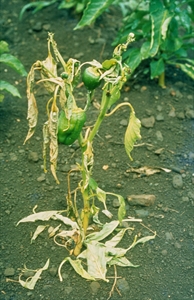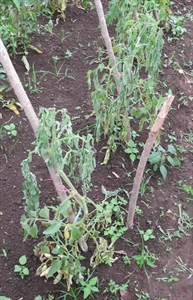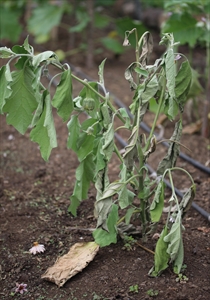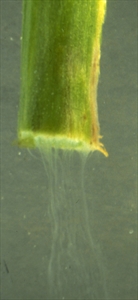Bacterial wilt, bacterial wilt of potato, bacterial wilt of Solanaceous crops
Pacific Pests, Pathogens, Weeds & Pesticides - Online edition
Pacific Pests, Pathogens, Weeds & Pesticides
Tomato bacterial wilt (146)
Ralstonia solanacearum. There are a number of races.
Asia, Africa, North, South and Central America, the Caribbean, Europe, Oceania. It is recorded from Australia (eggplant, ginger, potato, tomato), American Samoa (tomato), Cook Islands (capsicum, eggplant, potato), Fiji (eggplant, peanut, tobacco, tomato), French Polynesia (eggplant, potato), Guam, Federated States of Micronesia (capsicum, eggplant, potato, tomato), New Caledonia (capsicum, eggplant, potato, tomato), New Zealand, Palau (tomato, taro), Papua New Guinea (capsicum, eggplant, tobacco, tomato), Samoa (eggplant, potato, tomato), Tonga (potato, tomato), and Vanuatu (tomato).
Very wide: more than 200 hosts in more than 30 plant families. Race 1 affects many members of the family Solanaceae - eggplant, capsicum, chilli, potato, tomato and tobacco, and other families; race 2 banana (Moko disease); race 3 potato, tomato; race 4 ginger and race 5 mulberry. Race 1 strains are common in the tropics.
The first sign of wilt occurs on the youngest leaves, especially during the hottest part of the day. A few days later, and under conditions favourable to the disease - high temperatures and rainfall - plants wilt suddenly and die. However, if the conditions are not favourable, the disease may develop slowly; in that case: (i) the plants may be stunted, (ii) roots develop on the stem above soil level, and (iii) the lower leaves turn yellow before they wilt. Under both favourable and unfavourable conditions, brown stains are seen in the water-conducting system of the stem when it is cut across near soil level. On capsicum (Photo 1), there is a slower wilt, loss of leaves and dieback rather than a sudden wilt as occurs on tomato, potato (Photos 2&3) and eggplant (Photo 4).
Below ground, tips of the small feeder roots are destroyed, and some of the larger roots show a brown rot. As the disease advances, the entire root system is destroyed.
The bacteria enter roots through wounds made at planting, during cultivation, or by nematodes and insects. The bacteria can also enter the plants through natural wounds, such as those where roots emerge. Once inside the roots, the bacteria multiply in the water-conducting tubes called vessels, and block them with cells and slime, causing the plant to wilt.
Bacterial wilt spreads via root-to-root contact, and in ground water; greater spread is through movement of infected nursery plants, and in soil on machinery, tools and shoes. Seed transmission has been detected, but the level of infection is low.
Bacterial wilt is a serious disease on Solanaceous crops. Even though there are now many varieties that have tolerance, outbreaks of the disease can still occur when environmental conditions are favourable. The bacterium exists as a number of races. The one affecting Solanaceous crops in the tropics is race 1, biovar 3. Bacterial wilt is especially damaging in wet weather and at high temperatures, when it spreads rapidly between plants.
Look for a wilt of the youngest shoots during the warmest part of the day on plants that have sufficient water. Look for brown discolouration of the water-conducting system in stems cut at soil level; look to see the discolouration spreading to the pith, the central parts of the stem. A simple way to check that a plant has bacterial wilt is to cut out a short length of stem from the base of the plant, wash it, and then place it in a glass of water. If the disease is present, white streaks of bacterial cells and slime will flow from the cut end, after 3-5 minutes (Photo 5).
Bacterial wilt is a very difficult disease to control; there are many reasons for this: (i) the bacteria can remain alive in the soil without a host plant for about 9 months; (ii) the bacteria can survive for several years in host debris; (iii) the bacteria have a wide host range, infecting many crops and also weeds; and (iv) the bacteria can live on the roots of some plants without infecting them or causing a disease.
CULTURAL CONTROL
Cultural control is particularly important for this disease:
Before planting:
- If possible, avoid planting crops in land where bacterial wilt has occurred previously.
- If drainage is poor, plant on ridges or raised beds.
- Use bacterial wilt-resistant eggplant as rootstocks for wilt-susceptible tomatoes. Other (wild) Solanum species can also be used.
During growth:
- Remove wilted plants as soon as they are seen, taking as much soil from around the roots as possible, and burn the plants and soil. Do not let infested soil fall on neighbouring healthy plants.
- Use containers with pasteurised soil if fields are infested with the bacterium.
- Remove soil from machinery, tools and shoes and wash them with water after working in bacterial wilt contaminated fields.
After harvest:
- Use a crop rotation of at least 4 years, and during that time avoid susceptible crops and weeds in the Solanaceous family. Note, crop rotation is only of limited use against this disease because of long survival in the soil, and wide host range. Rotations with maize, soybeans, grasses and rice have been used in rotations elsewhere.
RESISTANT VARIETIES
There are tolerant varieties of tomato, chilli and eggplant. Check the lines available at AVRDC, The World Vegetable Center.
CHEMICAL CONTROL
There are no chemicals (except soil fumigants) that can be used to give satisfactory control of bacterial wilt.
AUTHOR Grahame Jackson
Information (and Photo 1) from Gerlach WWP (1988) Plant diseases of Western Samoa. Samoan German Crop Protection Project, Deutsche Gesellschaft für Technische Zusammenarbeit (GTZ) Gmbh, Germany; and (with Photo 5) Diseases of vegetable crops in Australia (2010) Editors, Denis Persley, et al. CSIRO Publishing. Photo 3 Anare Caucau, Research Division, Ministry of Agriculture, Fiji. Photo 4 Mike Furlong, University of Queensland, Brisbane.
Produced with support from the Australian Centre for International Agricultural Research under project PC/2010/090: Strengthening integrated crop management research in the Pacific Islands in support of sustainable intensification of high-value crop production, implemented by the University of Queensland and the Secretariat of the Pacific Community.








